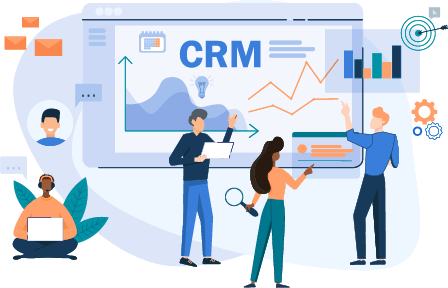Sometimes, it can be challenging to get the most out of a solution you've purchased for your business. CRM software allows companies to track overall sales, log customer information, and monitor company goals, but organizing the correct reports and drilling down into the most impactful metrics can be challenging.
Before you dive into what metrics are the right ones to track for your business, it's important to flesh out your business's overall goals and game plan. This can allow data to buttress your strategies, as opposed to collecting data without context.
How CRM metrics are effective
CRM metrics play a vital role in establishing benchmarks for companies. When you define what metrics are important for your business, you then have the proper insights to make actionable business decisions and align company practices with the broader strategy.
Getting the most out of your CRM software can lead to higher sales, more engagement with customers and enhanced efficiency among your employees.
Editor's note: Looking for the right CRM software or your business? Fill out the below questionnaire to have our vendor partners contact you about your needs.
Checking for accurate data
Your CRM metrics and reporting are only as precise as the data you're collecting. If you have inaccurate data, your insights will be off-base. Studies also show that bad data costs companies approximately 550 hours and as much as $32,000 per sales rep.
Before you can identify and track important metrics, you have to first verify that the information you're using is accurate. There are three steps you can take that will help ensure this:
- Scrub existing data for mistakes
- Work with those who have access to data collection in your organization
- Remain vigilant
Combing through your company's data will take you and your team time, but it will weed out important redundancies and inaccuracies, like double-submitted forms, incorrect customer information, and improper sourcing.
Once you've combed through the data, work with members of your organization who have access to data collection and the overall data collection process. Ensure that they're trained in handling sensitive data. Make sure they know how to handle potential phishing attacks. Part of maintaining accurate data is taking data security seriously. Oftentimes, companies limit those with access to data collection processes to only a few employees. That way, if there's a mistake, it can be easily traced and rectified.
Data collection is an ongoing process, so you need to remain vigilant of the overall flow of data collection. This can ensure your organization is doing its best to maintain accurate data and thus derive accurate CRM metrics and reporting.
List of CRM metrics
Before diving into the essential metrics you want to focus on tracking closely, here's a list of the information that CRMs can collect:
- Number of prospects
- Number of new customers
- Number of retained customers
- Close rate
- Renewal rate
- Number of sales calls made
- Number of sales calls per opportunity
- Amount of new revenue
- Number of open opportunities
- Sales stage duration
- Sales cycle duration
- Number of proposals given
- Number of campaigns
- Number of campaign responses
- Number of campaign purchases
- Revenue generated by a campaign
- Number of new customers acquired by campaign
- Number of customer referrals
- Number of web page views
- User goal completion rate on the web
- Time per website visit
- Customer lifetime value
- Cross-sell ratio
- Upsell ratio
- Email list growth rate
- Number of cases handled
- Number of cases closed the same day
- Average time to resolution
- The average number of service calls per day
- Complaint time to resolution
- Number of customer callbacks
- Average service cost per service interaction
- Percentage compliance with service level agreements
- Calls lost before being answered
- Average call handling time
3 ways to look at CRM metrics
As you can see, there is a lot that CRMs track. To digest the multitude of metrics at your fingertips, you may find it helpful to classify them into three categories: business performance metrics, user adoption metrics and customer perception metrics.
Bill Band, a CRM thought leader, created these three categories as a way to better grasp CRM metrics and how they can help your business. From a high-level perspective, Band said that companies that combine insights gleaned from internal, operations-based metrics with metrics involving customer perception become dynamic or, in other words, really competitive. You'll be able to draw important connections that otherwise would have gone unnoticed. Here are the various metrics and what information is typically included in each category:
- Business performance metrics. These metrics handle important concepts like sales pipelines, representative performance and forecasted numbers. These metrics are ideal for measuring how your company is progressing toward your ultimate business goals.
- User adoption metrics. This is an internal CRM metric category that measures things like the number of employees who are actively using the CRM, how your workers are using the system and other IT metrics. Without understanding how your organization is using your CRM, it can be difficult to understand the other aspects of the data (and analysis) you are collecting.
- Customer perception metrics. These CRM metrics address how your customers interact with your business. Marquee metrics in this category include customer satisfaction, customer retention, and customer journey through your overall sales pipeline. This metric provides you with concrete data on how your business is meeting customers' needs.
5 essential CRM metrics to track
Because every company's business goals are different, the CRM metrics that are important will differ, too. However, these five CRM metrics apply to most companies:
1. Customer churn
This metric addresses how many customers you're losing during a given time period, be it monthly, quarterly or yearly. This metric can provide you with a clear picture of if (and when) you're losing customers. This figure is also oftentimes referred to as customer turnover and customer attrition. By tracking this figure, you can better inform your business strategy when it comes to keeping customers. It could also provide some insight into why they're leaving.
2. Net promoter score
This metric handles how satisfied customers are with your business. Throughout the sales process, you can ask customers to rate their experience with your company on a scale from one to 10. EngageBay recommends viewing the score customers assign you through these lenses:
- 0-6: Scores from this category of responders come from what EngageBay calls "detractors"; these are customers who can potentially negatively impact your company's reputation.
- 7-8: Scores in this range come from consumers called "passives"; these are customers who enjoy your product but don't have a strong attachment to it.
- 9-10: High scores come from customers EngageBay calls "promoters," or people who will recommend your product or service to others.
Tracking overall customer satisfaction can help you understand how customers perceive your business. Regardless of how you decide to define each rating, having some sort of feedback system linked to your CRM solution can help you better understand your customers' experience.
3. Customer effort score
This metric also measures customer satisfaction, but it does so in relation to a customer's overall effort to receive service. Instead of just measuring satisfaction, it measures how much effort a customer has to put in to interact with (and ultimately purchase from) your business. For example, if a customer struggles to get in touch with a sales representative to get their basic questions answered, this score can measure that overall experience. This, when viewed in tandem with net promoter scores, can give businesses a clear picture of how their companies are perceived by their customers.
4. Rate of renewal
Rate of renewal addresses business growth. This is an important metric mainly for subscription-based businesses. It tracks how many customers continue using a product or service once they've signed up. Rate of renewal helps you understand your ability to retain customers, which allows you to plan a targeted growth strategy for boosting retention while generating new leads.
5. Customer retention cost
Much like the rate of renewal, customer retention is essential for any business to measure to understand overall growth. By viewing retention in relation to cost, you can identify whether it's costing your business too much money to preserve a high retention rate. Pegging customer retention to cost makes the true value of that rate clearer.


